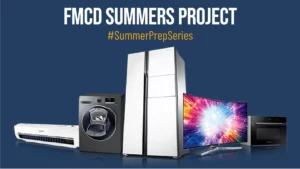
With this summer prep series, we want to help you crack a PPO in your summers. And if your summers is in FMCD, you’re at the right place. Unlike FMCG, FMCD consists of slow moving consumer durables like televisions, washing machines, lightings, paints etc. which is not only for retailers but also for corporates & government. In addition to slow moving nature of durables, the main differences are the high ticket size, type of products and the way you push sales even during low demand cycles. Cracking a PPO in FMCD companies like Asian Paints, Samsung, Philips etc. can set you up for your career. To help you with this, we are going to decode a project to give you an idea about how to approach your summers project in FMCD. Without further ado, let’s deep dive into the FMCD project.
Summer Internship Project: Understand the solvent based polish market and develop a GTM strategy for Ocian Paints to launch a product in the same category.
Project Brief
Solvent based polish is often applied as a protective undercoat to paint on most wooden furniture. It is also used as a primary low cost coat on wooden surfaces. The market for solvent based polish is primarily unorganized with many small regional players across different geographies. ‘Lak Daana’ or seed lakh is a wood polish made my harnessing the resin formed by the lac bug on trees. It is used in the major part of India as a substitute to solvent based polish. Ocian Paints sees an opportunity in the solvent based polish market in providing a branded high quality product for the market’s needs of a pre paint coating. It also wishes to act as the polish of choice over the traditionally used Lak Daana.
Objective and Deliverables
- Study the unorganized market for solvent based polish across geographies in North and West India.
- Consumer research to understand what stakeholders at the level of contractors, dealers and end consumers are looking for in the category. Communicate the same to R&D team.
- Suggest how Ocian Paint’s new product can gain market share over traditionally used wooden coating of Lak Daana.
- Develop pricing strategy for the new solvent based polish.
- Suggest promotion tools in the form of a push/pull strategy for the product.
Approach
- Understanding of the wood finishing segment as a whole including solvent based polishes as well as traditionally used substances such as Lak Daana.
- Understanding the current Ocian Paints wood polishing portfolio and product offerings including pigments such as touchwood and melamine.
- Study of the solvent based polish market across the geographies of North and West India by extensively travelling to the outskirts of Mumbai and Delhi meeting with contractors, dealers, applicators and end consumers.
- Identifying pain points of current solvent based polishes made available by local manufacturers as well as pain points caused by the use of Lak Daana. This was done through consumer immersions across the suburban Delhi and Mumbai geographies. Interaction with contractors, applicators and dealers was done to understand what the present issues were that a superior product could solve for.
- Meeting the RnD team based out of Mumbai and communicating the needs of intermediaries as well as end consumer to them in order to design Ocian Paint’s product.
- Collating findings of primary research. Final layer of paint was a high involvement product for end consumers however initial coating layer was a low involvement category.
- The pain points of locally manufactured solvent based polishes were irregularities in quality, lack of aesthetic appeal in terms of shine, higher drying time, low grain filling and sandibility.
- The pain points of Lak Daana identified were the difficult and time consuming melting process along with whitening of surface in colder temperatures during winter months.
- A product perception rating scale was formed taking into account 5 desirability factors of wooden polish that Ocian Paints R&D team could work towards in crafting the solvent based polish. These included: drying time, grain filling, sandibility, color compatibility and glossiness. The product perception rating scale included parameters relevant to intermediaries such as applicators and dealers as well as end consumers.
- Intermediaries in the sales channel were interviewed about their product perception rating of the developed scale for 2 geographical competitors: Cat Polish and Sheen Lad along with Lak Daana.
- Intermediaries were asked about their willingness to buy an Ocian Paints solvent based polish that would eliminate pain points, provide higher convenience in comparison to existing wooden polishes at an X% premium.
Stakeholders
External: Intermediaries in sales channels including contractors, dealers and applicators
Internal: R&D team & finance team
End Result
- Product persecution ratings were used to advice R&D team on new product development for Ocian Paint’s solvent based polish
- Pricing for the new product was developed by benchmarking with local products and monetizing the value added by Ocian Paints
- A push strategy was formulated to the end consumer and a pull strategy for intermediaries in promoting the new product (20% dealer driven, 80% contractor driven)
- Relevant insights on the existing market were used to come up with key opportunity areas for Ocian Paints and market potential was analyzed in North and West zone
- Loyalty programs for dealers and contractors were designed
- 86% of West region contractors and 90% of North region contractors were willing to purchase the quality enhanced Ocian Paints product at X% premium
Challenges
- The pricing strategy for a newly developed product in the R&D stage was a herculean task. This new product had to compete with traditionally used substitutes that consumers were long habituated of. Quality and convenience would be a key parameter for Ocian Paints to win over traditional substances. Pricing had to be value based and the only way to gauge what value was being added was to conduct extensive market immersion surveys on ground with dealers and contractors and gauge how much they would be willing to pay.
- The wide scope of project enabled a hands on learning experience of working on the 4Ps of marketing. This came with its own set of challenges. Not only did the product itself have to be defined with the R&D team but pricing had to be done with the finance team, channels navigated with sales team and promotion discussed with marketing team. Navigating all stakeholders and sometimes having to compromise the interest of one for the other was a challenge.
- Avoiding marketing myopia was another challenge. It was known that Ocian Paints could come up with a superior product to substitute Lak Daana. However, gauging whether there even was demand for the product at a premium price was important. Solvent based polishes were used as an outer layer of covering without paint by highly price sensitive budget consumers and those in the higher ranges considered it an extremely low involvement product. Thus, sales channel members were targeted and marketed to instead of end consumers based on the rating scale developed for them.
End Review Questions
Project specific
- Elaborate how you came up with the rating scale? Did each factor have the same weightage?
- Discussion on pricing of product and key differentiators for a value based pricing approach.
- What were the challenges you faced in each phase of the project?
- You still have 1 week remaining in the internship, what would you like to do?
- What did you understand about the sales channel?
HR + General questions
- How was your experience travelling to tier 2 and tier 3 towns and engaging with intermediaries in the sales channels?
- Will you be comfortable pursuing a career in sales?
- Why Ocian Paints?
- Now this is just one type of project you might get.
Although, projects across sectors tend to have a lot in common. So make sure, you keep an eye out for other sector projects as well.
This article was written by Sneha Roy from FMS.
Check out our courses











